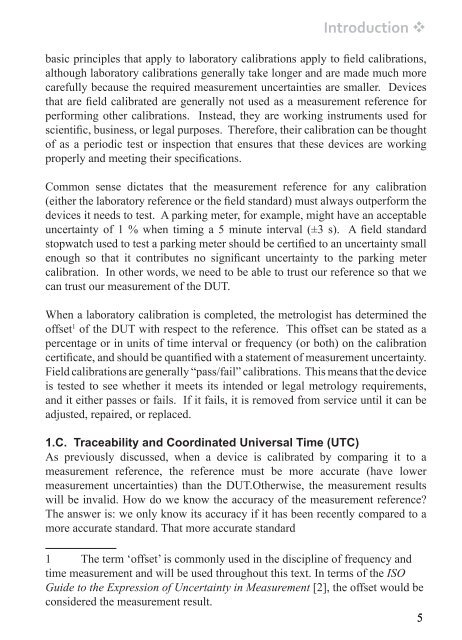Stopwatch and Timer Calibrations - National Institute of Standards ...
Stopwatch and Timer Calibrations - National Institute of Standards ...
Stopwatch and Timer Calibrations - National Institute of Standards ...
- No tags were found...
Create successful ePaper yourself
Turn your PDF publications into a flip-book with our unique Google optimized e-Paper software.
Introduction <br />
basic principles that apply to laboratory calibrations apply to field calibrations,<br />
although laboratory calibrations generally take longer <strong>and</strong> are made much more<br />
carefully because the required measurement uncertainties are smaller. Devices<br />
that are field calibrated are generally not used as a measurement reference for<br />
performing other calibrations. Instead, they are working instruments used for<br />
scientific, business, or legal purposes. Therefore, their calibration can be thought<br />
<strong>of</strong> as a periodic test or inspection that ensures that these devices are working<br />
properly <strong>and</strong> meeting their specifications.<br />
Common sense dictates that the measurement reference for any calibration<br />
(either the laboratory reference or the field st<strong>and</strong>ard) must always outperform the<br />
devices it needs to test. A parking meter, for example, might have an acceptable<br />
uncertainty <strong>of</strong> 1 % when timing a 5 minute interval (±3 s). A field st<strong>and</strong>ard<br />
stopwatch used to test a parking meter should be certified to an uncertainty small<br />
enough so that it contributes no significant uncertainty to the parking meter<br />
calibration. In other words, we need to be able to trust our reference so that we<br />
can trust our measurement <strong>of</strong> the DUT.<br />
When a laboratory calibration is completed, the metrologist has determined the<br />
<strong>of</strong>fset 1 <strong>of</strong> the DUT with respect to the reference. This <strong>of</strong>fset can be stated as a<br />
percentage or in units <strong>of</strong> time interval or frequency (or both) on the calibration<br />
certificate, <strong>and</strong> should be quantified with a statement <strong>of</strong> measurement uncertainty.<br />
Field calibrations are generally “pass/fail” calibrations. This means that the device<br />
is tested to see whether it meets its intended or legal metrology requirements,<br />
<strong>and</strong> it either passes or fails. If it fails, it is removed from service until it can be<br />
adjusted, repaired, or replaced.<br />
1.C. Traceability <strong>and</strong> Coordinated Universal Time (UTC)<br />
As previously discussed, when a device is calibrated by comparing it to a<br />
measurement reference, the reference must be more accurate (have lower<br />
measurement uncertainties) than the DUT.Otherwise, the measurement results<br />
will be invalid. How do we know the accuracy <strong>of</strong> the measurement reference<br />
The answer is: we only know its accuracy if it has been recently compared to a<br />
more accurate st<strong>and</strong>ard. That more accurate st<strong>and</strong>ard<br />
1 The term ‘<strong>of</strong>fset’ is commonly used in the discipline <strong>of</strong> frequency <strong>and</strong><br />
time measurement <strong>and</strong> will be used throughout this text. In terms <strong>of</strong> the ISO<br />
Guide to the Expression <strong>of</strong> Uncertainty in Measurement [2], the <strong>of</strong>fset would be<br />
considered the measurement result.<br />
5
















